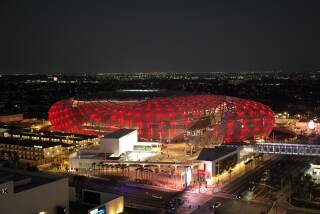The Really Big Screen Gets Bigger
- Share via
Sometimes bigger is better.
Such is the case with the new seven-story Imax Theater, which opens to the public on Saturday as part of the new California Science Center (nee Museum of Science and Industry) in Exposition Park.
Not that the old five-story theater was anything to sneeze at. Film critics and filmgoers alike never failed to mention the powerful experience of watching a large-format film on the giant screen, even if the film itself was subpar.
But when the plan was hatched in 1988 to build a science center that would meet the needs of today’s technologically sophisticated kids, an upgraded theater was a no-brainer.
“It was natural to take the next step up to have Imax 3-D as well as 2-D,” said Joe De Amicis, vice president of marketing for the theater.
In the past few years the Imax Theater has drawn 500,000 people annually. “We expect 700,000 annually with this new theater,” De Amicis said.
That’s quite an increase but the new 3-D capabilities might just do it for them. Before now, L.A. and San Fernando Valley residents had to commute to Irvine or Ontario to see Imax 3-D.
The new theater, as well as being two stories taller, is 20 feet wider and has 60 more seats. And in this ergonomic age, other changes were included.
“There are fewer seats across in a row. It’s a little bit more elevated and a little bit more enclosed,” explains De Amicis. “We changed the seating style to increase the feeling of your whole peripheral vision being encompassed by the screen.”
Also enhancing the 3-D experience are the new 3-D glasses. After testing several types, the theater operators chose very lightweight, oversized, polarized glasses that really do bring the images closer to the audience. They’re nothing like the space-like headset used at Irvine and Ontario.
To make it even more like a movie movie experience, a concession stand in the lobby will sell traditional filmgoer favorites--popcorn, sodas, hot dogs--but alas, there are no cup holders attached to the seats in the auditorium.
“The sound system is a digital sonic sound system; 44 speakers, 12,000 watts of sound,” De Amicis said. “It’s just much more finely tuned in terms of the visitor listening experience.”
And visitor experience is important. The entire science center depends on the theater to both draw interest to the center and provide much needed revenue.
“The theater is one of the financial anchors for the whole science center, which is free to the public,” he said. “This is one of the ways we can maintain our free status.”
Results from test audiences have been enthusiastic.
“The kids love this stuff. We had a bunch of school groups come through who got to see ‘Into the Deep,’ and they were reaching out and trying to grab [the 3-D images],” says De Amicis. “That might be the best way to experience a film like this because kids are just so uninhibited. They flail their arms and scream, and of course the kid in us wants to do the same.”
But Imax is more than just kid stuff. And this new theater, the first institutional Imax 3-D theater in the Los Angeles area (the ones in Irvine and Ontario are commercial venues owned by the Edwards Theater chain), will be an important showcase for the Toronto-based Imax Corp., which is increasingly becoming involved in producing and distributing strictly entertainment fare.
Though they will continue to produce and promote documentaries and educational films, Richard Galfon, vice chairman and co-CEO of Imax Corp., says there is room for growth.
“There’s a place in Imax for purely educational films, and there’s a place for purely entertaining films, as well as films that accomplish both,” Galfon said in a telephone interview from his Toronto office.
“We’re in advanced discussions with Paramount--we have a script in development--to release a 3-D ‘Star Trek’ film in Imax.”
“One of the other directions we’re going in is 3-D animation, because, we think, given our strong brand name toward family entertainment, and given the immersive nature of our 3-D technology, that animation is a natural.”
(“Paint Misbehavin,” a two-minute 3-D animated short, will precede screenings of “Into the Deep” at the new theater.)
Galfon spoke excitedly even about the more immediate future, saying, “This year will be one of the best years in our history in terms of film product.”
Coming attractions include “Everest,” shot at the time of the mountain-climbing tragedy Jon Krakauer wrote about in “Into Thin Air,” and a fall release directed by Brett Leonard (“Virtuosity” and “Lawnmower Man”) called “T-Rex: Back to the Crustaceous,” with 3-D dinosaurs.
So while changes are afoot for the large-format leader, Galfon stresses that “the central premise to everything we do, is to provide something that is geared to the family.”
Educational films will still rule at the California Science Center’s theater, De Amicis said.
“The film programming will enhance what we’re doing in the science center. For instance, one of the next films we’re going to open is ‘Africa’s Elephant Kingdom.’ How do we take that film and build a science workshop around that?”
“We want to create a real thematic experience, and that’s our strength as a science center. As commercial Imax develops, how do we differentiate ourselves from them? And one of the ways is we’ll be true to our mission: science learning.”
BE THERE
Imax Theater, California Science Center, 700 State Drive, Exposition Park. $3.75-$7.25. Parking $5. (213) 744-2014.
More to Read
The biggest entertainment stories
Get our big stories about Hollywood, film, television, music, arts, culture and more right in your inbox as soon as they publish.
You may occasionally receive promotional content from the Los Angeles Times.










